We can all agree that user-generated content (UGC) like ratings and reviews is important.
But, why is it so important? What is it about ratings and reviews that drives customers to purchase? And what about other types of UGC, like videos, images, and Q&A?
How do customers interact with this type of content, and what impact does it ultimately have on their decision to click the “Buy Now” button?
At PowerReviews, we decided to find out. Our analysts mined the data from thousands of brands and retailers using our UGC Analytics technology to see how frequently customers interacted with UGC, how it impacted the buyer journey, and whether certain types of UGC were more effective than others in driving conversions.
Read on to discover what we found, along with pro tips for applying these insights to your own UGC.
Customers Who Interact With UGC Are 103% More Likely to Convert
That’s right. Customers who engage with some form of UGC — be it reviews, imagery, or Q&A — are twice as likely to convert than customers who don’t.
Here’s the better news. A majority of online shoppers (77%) interact with UGC when it’s available. Which type of UGC is most helpful to pushing customers through that barrier to purchase? Here are the results:
- Q&A is the most impactful content (153% increase in conversion)
- Reviews were in second place (115% increase in conversion)
- Imagery rounded out the list (81% increase in conversion)
Let’s look at some examples of these types of UGC in the wild, and why they’re so impactful on customer purchasing decisions.
Ratings and Reviews
Ratings and reviews allow customers to share their experience with a product or service, and give it an overall star rating.
How important are reviews? After price, reviews are the second-most important factor to customers making a purchase decision. Displaying ratings and reviews on your product page can lift conversions by 115%.
Why? Ratings and reviews provide invaluable social proof to shoppers. They can’t see, touch, and smell a product they’re purchasing online. But when they read the reviews, shoppers can cross-reference with people who have already purchased your product, to verify that it looks and works like you say it does.
Reviews help answer questions shoppers have about your products. They can learn from others’ experiences, both positive and negative.
Yes, even negative UGC is helpful! Our data shows that two-thirds of visitors filter for 1-star reviews when interacting with UGC. Those visitors still convert at 108% the rate of your general web traffic. People want to see one-star reviews because it helps them better evaluate whether a product is the right fit for them. When it comes to UGC, a negative really can be a positive.
A lot of the time, something that is a negative, one-star-worthy dealbreaker for one shopper might not be a big deal for another.
For example, say a shopper is searching for a pair of slipper-type shoes that she can wear outdoors when running errands. She finds a pair of slippers that look perfect, but wants to look through the one-star reviews to see if there’s anything jarringly wrong with the slippers before buying.
She sees that some previous buyers gave the slippers 1-star because they don’t have enough fuzziness on the inside to keep their feet warm enough. The shopper, who lives in Miami, will be wearing the slippers in the hot Florida climate, so really this one-star review validates that these slippers are perfect for her.
WEBS – America’s Yarn Store makes it easy for customers to glean the information they’re looking for from their reviews. Their product pages feature a Review snapshot that captures the average star rating, ratings distribution, pros and cons, and a most liked negative and positive review.
And with PowerReviews’ UGC Analytics, they can understand the exact ROI of each of the features they are displaying on their site — from pros and cons to visual content.
This presentation of unbiased UGC increases customer trust. It also keeps customers on site, as WEBS eCommerce Manager Dena Childs shared. “You never want a customer to leave your website, hoping to find the information they need somewhere else. Customer content builds confidence, and PowerReviews has allowed us to showcase that social proof on our site, facilitating the path to purchase for our customers.”
Reviews help your shoppers make a more confident purchase decision. The more you can do to make your reviews more useful to customers, the better. For example, Briogeo added custom fields to their review form to better categorize and sort their review content.
When displayed on the product page, these fields help customers navigate to relevant information faster, increasing trust and satisfaction. The filters show the wide range of hair types Briogeo products work on, and enable customers to filter to read reviews from customers like them:
Reviews aren’t just good for customers. They’re good for brands, too. Room & Board has reviews or Q&A for nearly 80% of products on their site. The customers who interact with these features have a 95% higher conversion rate than those who don’t.
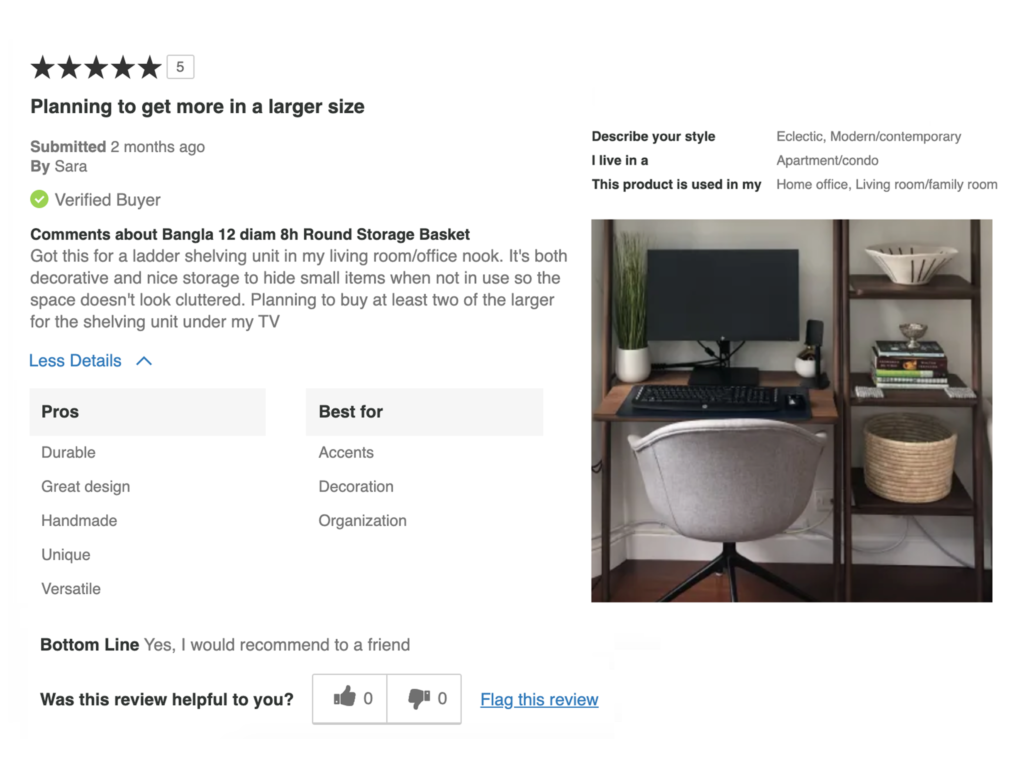
Q&A
Q&A are like mini-FAQ sections for each of your products. Instead of reading every review, customers can find answers and ask questions related to the specific product they are considering. They can ask about anything: size, function, appearance, durability, shipping and delivery times.
How impactful is Q&A? Of all types of UGC, our research shows Q&A is the most impactful content, driving a 153% increase in conversions.
Why? Q&A helps your customers decide if they really want to buy your product. They might be wondering, “Are these rain boots good enough for Seattle to wear them all the time? Are they waterproof?” With Q&A, they can get those answers instantly — or ask themselves and get an answer in a timely manner. Best of all, their answers come from previous brand buyers, or actual brand experts from your company.
Duraflame’s Q&A are manned by brand experts like Jessica. Jessica’s answers demonstrate the knowledge the Duraflame team has, impressing shoppers and earning their trust. They’re also helpful for learning the answer to very important questions, like whether their firelogs are safe for s’mores! (They’re not — opt for their Campfire Roasting Logs instead.)
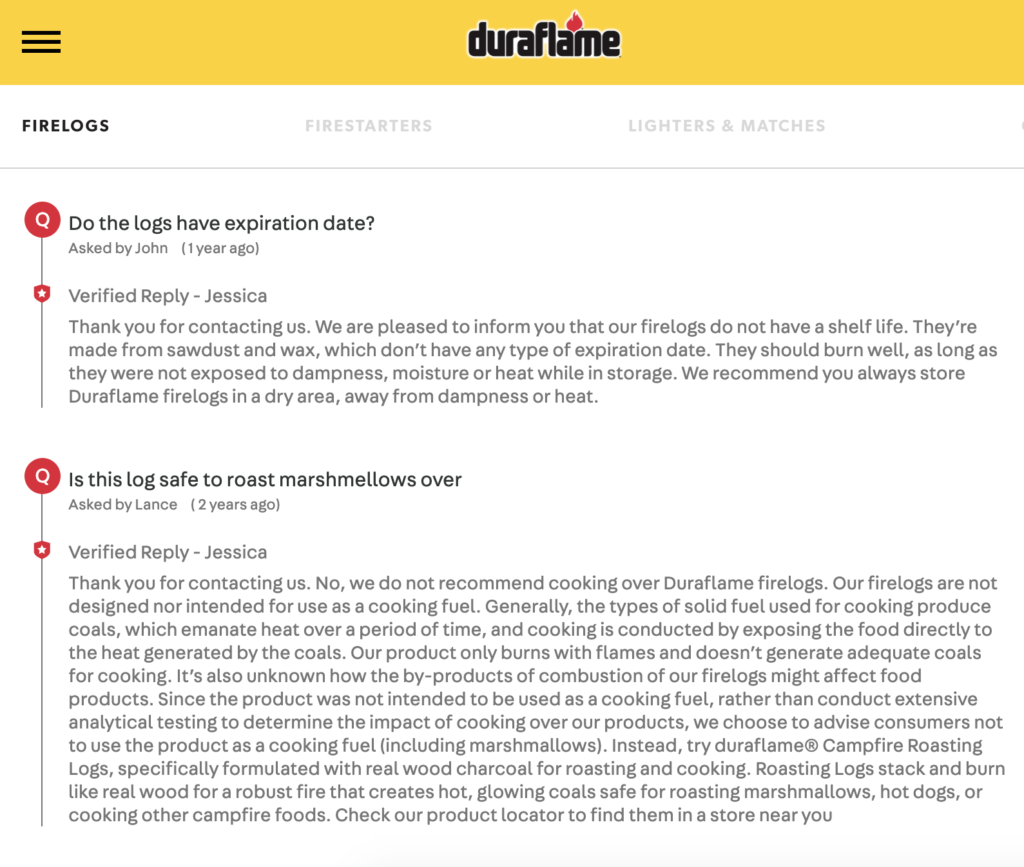
Pro Tip: Pre-seed Q&A for a new product page if there are questions you think will be asked. Add them before someone has to ask, so it’s already there and they don’t have to wait.
What should you do when new questions come in? Answer them quickly. Skechers commits to response times of 3 hours or less.
How’s that worked out for them? More than half (51%) of shoppers who receive an answer to their question ended up purchasing the product. “Because a customer who submits a question is already engaged, if we can give them the answer they want in a timely fashion, they usually buy the shoe,” shared Tim Lakin, Ecommerce Merchandising Manager for Skechers.
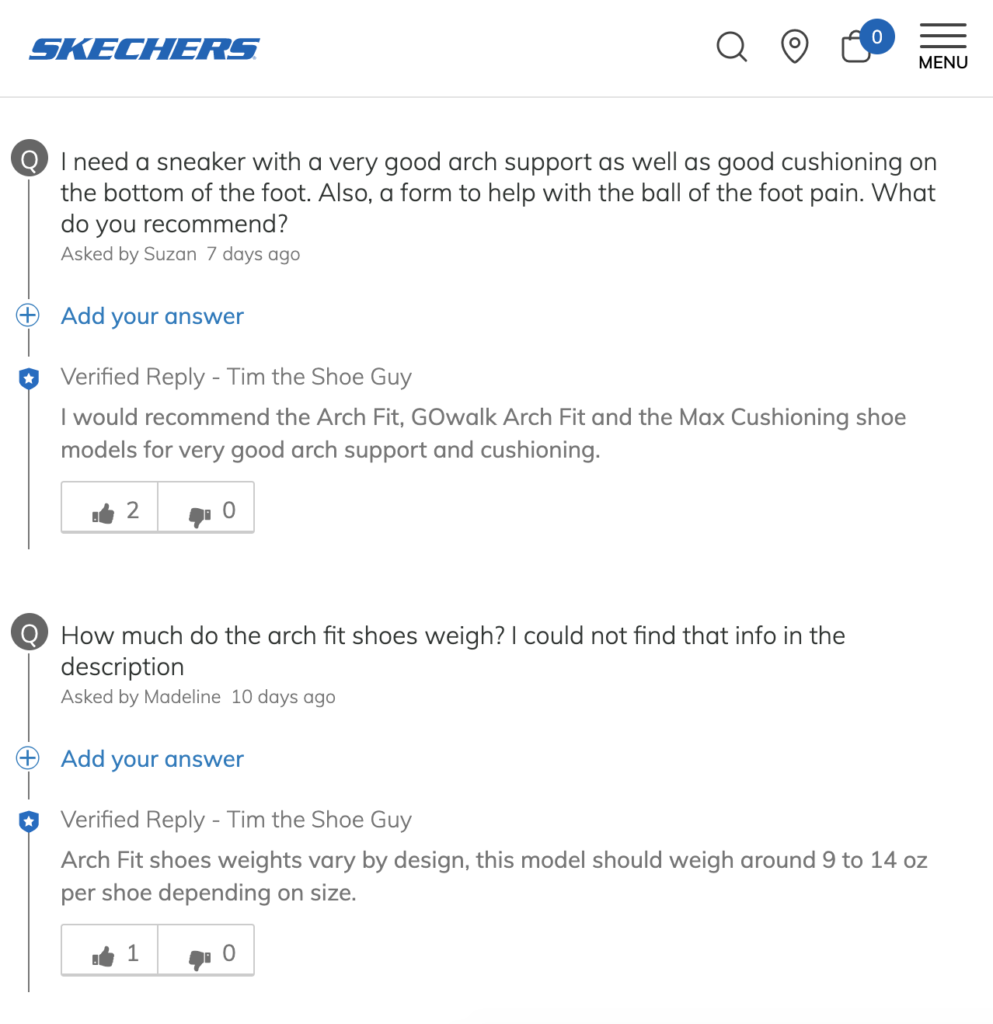
You can also use Q&A to cross-sell other products, like MAC Cosmetics does. In the Q&A for their Matte Lipstick, brand experts offer tips for getting more out of lipstick by using it with a matching lip liner and lip brush, with links to the respective product pages.
As an added bonus, Q&A happens to be great for SEO. It’s a really good way to get fresh content from your customers, which is something Google really prioritizes. With more fresh content, you increase your opportunities to rank for related search terms, and increase traffic to your site. “With Questions & Answers, we were able to boost [Skechers’] rankings in Google’s organic search for the keyword ‘shoes’ to be on the first page of results,” shared Lakin.
Image and Video Content
Image and video content bring UGC to life, whether customers upload their media directly through your website or you curate it from Instagram. It adds visual interest to your product page and motivates shoppers to convert.
How impactful is UGC imagery? Online shoppers who interact with UGC imagery are 81% more likely to convert.
Why? Image and video content is so important because it accomplishes three things:
1. It builds customer trust.
By browsing through customer-submitted photos, shoppers can see what an item looks like when it comes in the mail, and verify that it matches your product photos.
It also gets them excited to purchase the product, because they can visualize using it and imagine all the possibilities. Canyon Bakehouse encourages customers to share photos of dishes they’ve made using their gluten-free bread, giving future buyers fun recipe ideas:
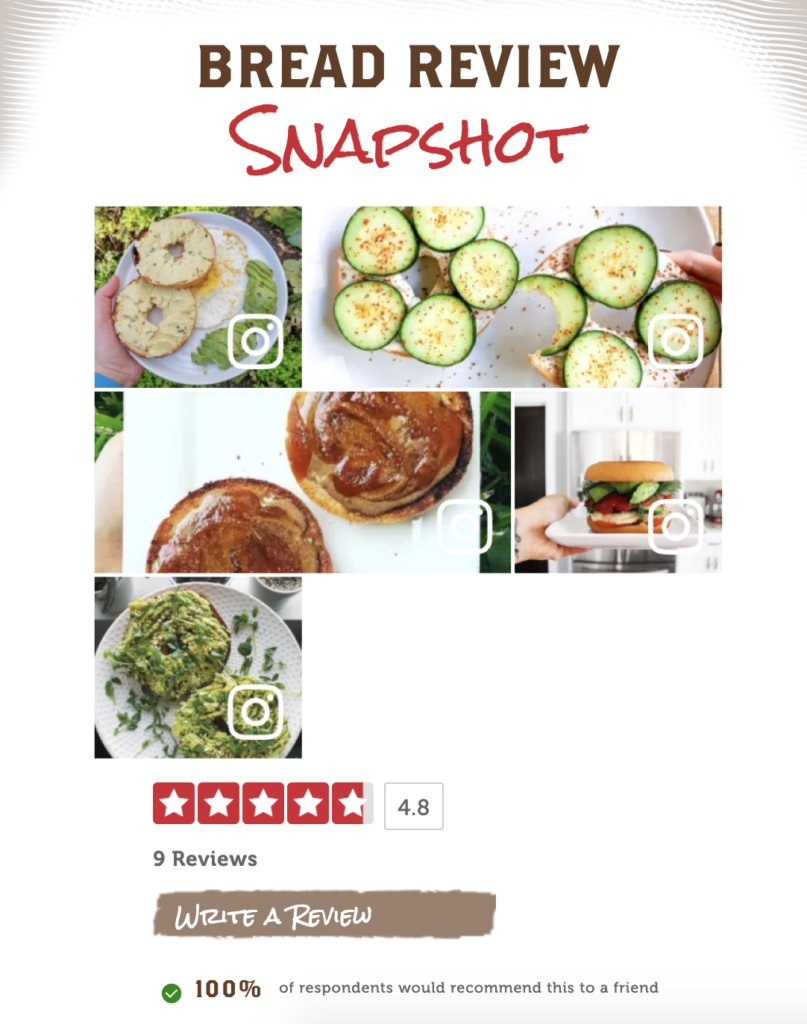
2. It helps customers understand the size of the product.
Sleek as they may look, stock photography or product photos with white backgrounds give customers no reference for how big (or small) your product is.
One of my colleagues recently bought a basket on Amazon for raffle tickets. She thought it would fit 500 tickets, but when it arrived, it was so tiny it could fit in the palm of her hand. So, she had to return it. That return cost the retailer money that could have easily been avoided with a customer photo that put it on a coffee table.
Shure Incorporated has collected over 1,200 images from social media for their product pages. These show customers the size of the product and the type of packaging it arrives in, avoiding scenarios like what happened to my colleague.
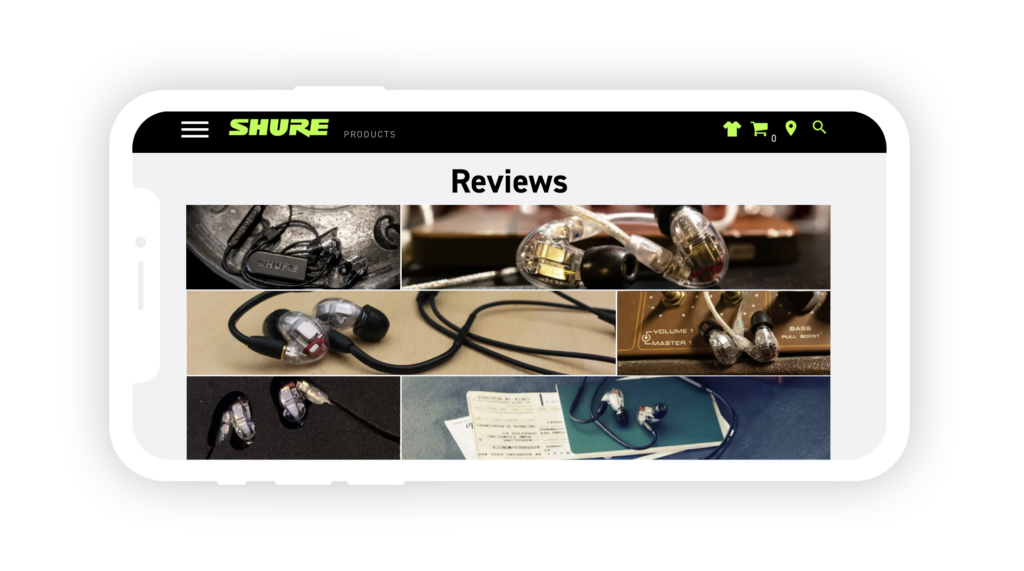
3. For apparel and cosmetics, it helps shoppers see what the product looks like on different types of people.
A dress on a 6-feet-tall model will look different on a shopper who’s 5’4”. UGC photos help shoppers determine how well your products will fit them.
In addition to photos, you can ask questions in your review form to help shoppers assess fit, like Janie and Jack does. Shoppers can rate how “true to size” a product is, and describe the age of the child they purchased it for. Reviewers also have the option to upload a photo, which you can then display in shoppable visual content galleries across your website on product, category, hashtag, or homepages to increase sales and inspire other purchases.
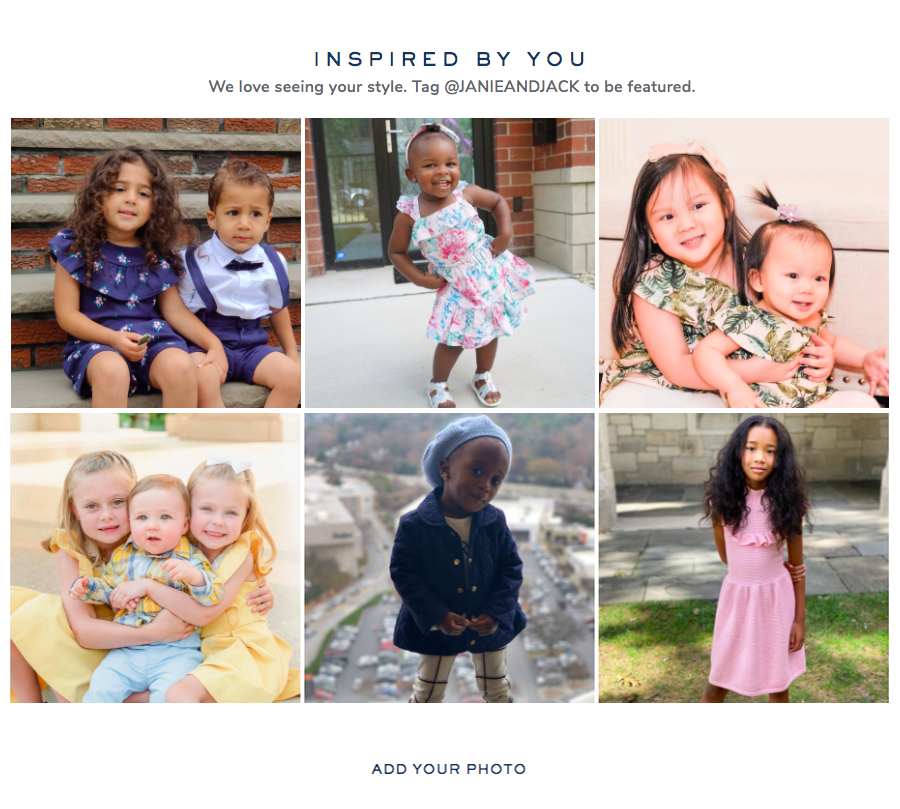
In the end, it all goes back to helping your customers make confident purchase decisions. The more information you can provide your shoppers with — using actual customer images — the more likely they are to buy something they actually want. That means fewer returns (which can get expensive), and more successful purchases!
The Power of UGC
The most exciting thing about UGC is how quickly it works. When we look at our PowerReviews client data, the average online customer might have a super low conversion rate, say around 4%. But when that same customer simply interacts with UGC — even if they just click on an image or expand a Q&A — it skyrockets to something like 11%. It’s really powerful. Interested in how UGC can impact your conversion rates? Our PDP Site Analytics (where we mined this data) is available for all PowerReviews clients who use Ratings and Reviews. Find out how our UGC solutions can boost your sales by 92%.


